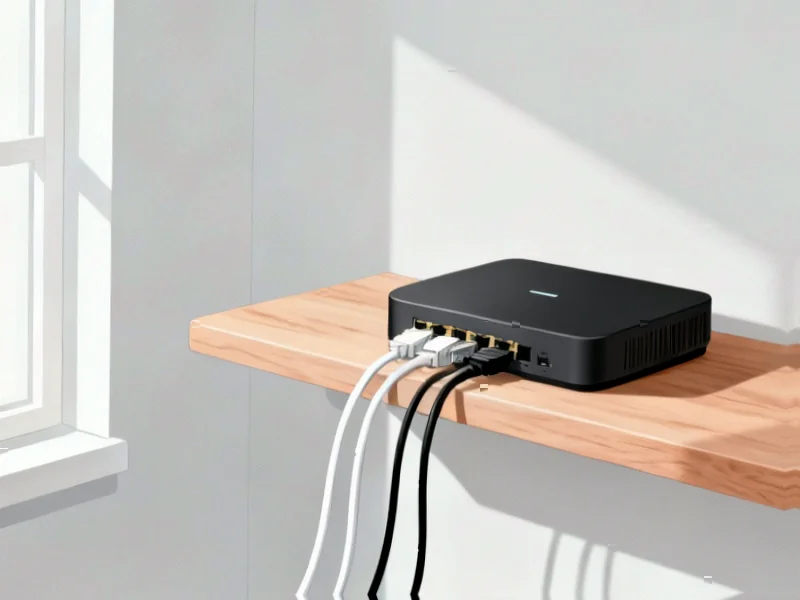According to XDA-Developers, one of their technology experts has embraced a deliberately simple home network setup despite working in an environment where complex configurations are the norm. The author uses a single GL.iNet Flint 2 router with separate 2.4GHz and 5GHz bands but no VLANs or guest networks, finding the router’s coverage sufficient for a large apartment. The most complex element is an improvised NAS running TrueNAS, Jellyfin, and Home Assistant with Tailscale for remote access, plus AdGuard Home built into the router for network-wide ad blocking. The author consciously avoids redundancy systems and complex security measures, arguing that for many users, simplicity provides adequate protection and reliability without unnecessary complexity.
Table of Contents
The Counterintuitive Security of Simplicity
While security experts often recommend complex network segmentation through VLANs and multiple layers of protection, there’s a compelling argument that simpler setups can actually be more secure for average users. Complex configurations introduce potential misconfiguration risks, maintenance overhead, and false confidence. Many security breaches occur not because networks lacked sophisticated protections, but because basic security principles weren’t properly implemented. A well-configured single network with strong passwords, regular updates, and basic firewall rules can provide adequate protection for most households without the complexity that might lead to configuration errors or abandoned security measures.
The Modern Router Revolution
The author’s choice of the GL.iNet Flint 2 represents a significant shift in what consumer routers can accomplish. We’re seeing a convergence where mid-range consumer routers now incorporate features that previously required enterprise equipment or custom setups. Built-in ad blocking, VPN server capabilities, and advanced quality-of-service controls are becoming standard in routers costing under $200. This evolution means users can achieve sophisticated network management without the technical debt of maintaining multiple services across different devices. The trade-off, however, is vendor lock-in and potential limitations compared to open-source solutions.
The Remote Access Compromise
The author’s use of Tailscale represents a pragmatic approach to remote access that balances security with convenience. Traditional remote access solutions often require port forwarding, dynamic DNS, and constant security monitoring. Zero-trust solutions like Tailscale provide secure access without exposing services directly to the internet, significantly reducing the attack surface. This approach is particularly valuable for users who want occasional remote access to NAS systems or home automation without maintaining complex VPN infrastructures. However, it does create dependency on third-party services and may not satisfy users requiring maximum control over their networking stack.
The Consumer Networking Market Shift
This preference for simplicity reflects broader trends in consumer networking. Manufacturers are increasingly focusing on reliability and ease of use rather than packing devices with every possible feature. The success of mesh systems, while adding complexity in one dimension, actually simplifies coverage issues that previously required technical knowledge to solve. Meanwhile, the prosumer market is bifurcating between users who want powerful but simple solutions and those who enjoy the hobbyist aspect of complex home network configurations. This creates opportunities for companies that can deliver sophisticated capabilities through simple interfaces.
The Future of Home Networking
Looking forward, we’re likely to see continued tension between simplicity and capability in home networking. AI-driven network management promises to automate many complex configuration tasks, potentially making sophisticated setups accessible to non-technical users. Meanwhile, increasing IoT device adoption and bandwidth demands will continue pushing the boundaries of what home networks need to support. The most successful solutions will likely be those that provide enterprise-grade capabilities through consumer-friendly interfaces, allowing users to benefit from advanced networking features without the maintenance burden that often accompanies them.
When Simple Makes Sense
For most households, the author’s approach represents a reasonable balance between security and practicality. The critical factors in determining appropriate network complexity include the number of IoT devices, frequency of guest access, technical competency of household members, and sensitivity of stored data. Users with extensive smart home ecosystems or frequent visitors might benefit from additional segmentation, while those with basic needs can often achieve adequate security through simple measures. The key insight is that network security exists on a spectrum, and each household should calibrate their setup to their specific risk profile and technical comfort level.



